
Sternhalma, commonly known as Chinese checkers or Chinese chequers, is a strategy board game of German origin that can be played by two, three, four, or six people, playing individually or with partners. The game is a modern and simplified variation of the game Halma. "Complexity: requires no counting or spelling; even young children can play."
Chess strategy is the aspect of chess play concerned with evaluation of chess positions and setting goals and long-term plans for future play. While evaluating a position strategically, a player must take into account such factors as the relative value of the pieces on the board, pawn structure, king safety, position of pieces, and control of key squares and groups of squares. Chess strategy is distinguished from chess tactics, which is the aspect of play concerned with the move-by-move setting up of threats and defenses. Some authors distinguish static strategic imbalances, which tend to persist for many moves, from dynamic imbalances, which are temporary. This distinction affects the immediacy with which a sought-after plan should take effect. Until players reach the skill level of "master", chess tactics tend to ultimately decide the outcomes of games more often than strategy. Many chess coaches thus emphasize the study of tactics as the most efficient way to improve one's results in serious chess play.

The pawn is the most numerous and weakest piece in the game of chess. It may move one vacant square directly forward, it may move two vacant squares directly forward on its first move, and it may capture one square diagonally forward. Each player begins a game with eight pawns, one on each square of their second rank. The white pawns start on a2 through h2; the black pawns start on a7 through h7.
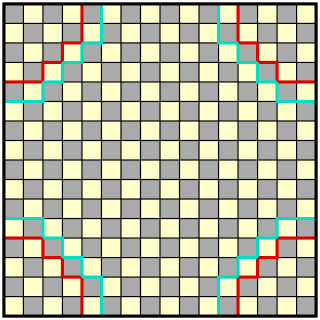
Halma is a strategy board game invented in 1883 or 1884 by George Howard Monks, an American thoracic surgeon at Harvard Medical School. His inspiration was the English game Hoppity which was devised in 1854.

The L game is a simple abstract strategy board game invented by Edward de Bono. It was introduced in his book The Five-Day Course in Thinking (1967).
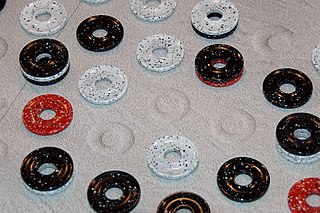
DVONN is a two-player strategy board game in which the objective is to accumulate pieces in stacks. It was released in 2001 by Kris Burm as the fourth game in the GIPF Project. DVONN won the 2002 International Gamers Award and the Games magazine Game of the Year Award in 2003.
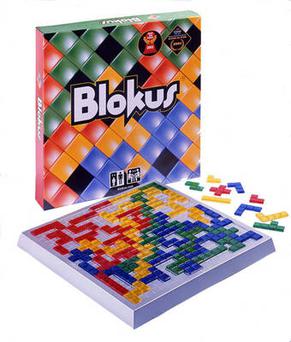
Blokus is an abstract strategy board game for two to four players, where players try to score points by occupying most of the board with pieces of their colour. The board is a square regular grid and the pieces are polyominoes. It was designed by French mathematician Bernard Tavitian and first released in 2000 by Sekkoïa, a French company. It has won several awards, including the Mensa Select award and the 2004 Teacher's Choice Award. In 2009, the game was sold to Mattel.

PÜNCT is a two-player strategy board game. It is the sixth release in the GIPF project of seven abstract strategy games, although it is considered the fifth game in the project. It was released in 2005. PÜNCT won the Games Magazine Best Abstract Strategy game for 2007.
Hive is a bug-themed tabletop abstract strategy game, designed by John Yianni and published in 2001 by Gen42 Games. The object of Hive is to capture the opponent's queen bee by allowing it to become completely surrounded by other pieces, while avoiding the capture of one's own queen. Hive shares elements of both tile-based games and board games. It differs from other tile-based games in that the tiles, once placed, can then be moved to other positions according to various rules, much like chess pieces.

Board representation in computer chess is a data structure in a chess program representing the position on the chessboard and associated game state. Board representation is fundamental to all aspects of a chess program including move generation, the evaluation function, and making and unmaking moves as well as maintaining the state of the game during play. Several different board representations exist. Chess programs often utilize more than one board representation at different times, for efficiency. Execution efficiency and memory footprint are the primary factors in choosing a board representation; secondary considerations are effort required to code, test and debug the application.

Banqi or Half Chess, also known as Dark Chess (暗棋) or Blind Chess (盲棋), is a two-player Chinese board game played on a 4×8 grid, or half of the xiangqi board. Most games last between ten and twenty minutes, but advanced games can last for an hour or more. Banqi is a social game, usually played for fun rather than serious competition. A more formal version of Banqi may have evolved into the games Jungle and modern Luzhanqi.

JumpStart Advanced 2nd Grade is a personal computer game created by Knowledge Adventure. It replaced the previous JumpStart 2nd Grade released in 1996. As its name suggests, it was made to teach second grade students. From 2003–2008, it was distributed as the "Fundamentals" disc in a 3- or 4-disc package of the same name, though recently a factory error in some packages caused the Fundamentals disc to be replaced by JumpStart 3D Virtual World: The Quest for the Color Meister going by the same name.

Bendomino is a tabletop strategy game similar to dominoes, created by Thierry Denoual and published by Blue Orange Games in 2007. It is a set of double-6 dominoes with a 120-degree curve. The main difference from dominoes is the curved shape of the pieces, which introduces a new level of strategy to the game. There is also a version of the game for younger players with pictures instead of numbers and symbols on the Bendomino tiles.
Pasang is a two-player abstract strategy board game from Brunei. The game is often referred to as Pasang Emas which is actually a software implementation of the traditional board game. The object of this game is to acquire the most points by capturing black and white tokens on the board. Black tokens are worth 1 point, and white tokens are worth 2 points. The board is initially laid out with all 120 black and white tokens in one of over 30 traditional patterns. Players choose a piece called a "ka" which is used to capture the tokens on the board. Each player's "ka" moves around the board capturing as many tokens as possible. As a note, the "kas" are the only mobile pieces in the game. The other pieces are stationary, and are captured by the "kas". Players must capture token(s) during their turn, or lose the game. When all tokens have been captured from the board, the player with the most points is the winner. However, if there are any tokens left on the board, and none can be captured on a player's turn, then that player loses the game, and the other player is the winner.
Tiger and buffaloes is a two-player abstract strategy board game from Myanmar. It belongs to the hunt game family. The board is a 4x4 square grid, where pieces are placed on the intersection points and move along the lines. It is one of the smallest hunt games. Three tigers are going up against eleven buffaloes. The tigers attempt to capture as many of the buffaloes by the short leap as in draughts or Alquerque. The buffaloes attempt to hem in the tigers.

Qwirkle is a tile-based game for two to four players, designed by Susan McKinley Ross and published by MindWare. Qwirkle shares some characteristics with the games Rummikub and Scrabble. It is distributed in Canada by game and puzzle company Outset Media. Qwirkle is considered by MindWare to be its most awarded game of all time. In 2011, Qwirkle won the Spiel des Jahres, widely considered the most prestigious award in the board and card game industry. A sequel, Qwirkle Cubes, was released by Mindware in 2009.
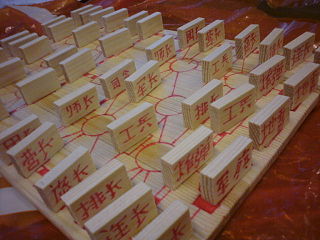
Luzhanqi is a two-player Chinese board game. There is also a version for four players. It bears many similarities to Dou Shou Qi, Game of the Generals and the Western board game Stratego. It is a non-perfect abstract strategy game of partial information, since each player has only limited knowledge concerning the disposition of the opposing pieces. Because of the Chinese nature of the game, terms used within the game may vary in translation.
Mojo is a two-player, 3 in-a-row abstract strategy board game played with original and unique "thrice-sliced-dice". The pieces, handmade to order in India, are colored with non-toxic vegetable dye. The individual opposite ends of the pieces are marked with pips and numbered similar to regular dice - i.e. they total 7. It takes all 3 pieces of a color to make up a single die.
This glossary of board games explains commonly used terms in board games, in alphabetical order. For a list of board games, see List of board games; for terms specific to chess, see Glossary of chess; for terms specific to chess problems, see Glossary of chess problems.
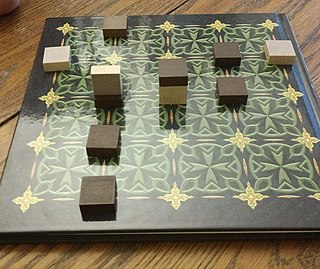
Tak is a two-player abstract strategy game that first existed fictionally within Patrick Rothfuss's fantasy trilogy, The Kingkiller Chronicle and was then brought to life by James Ernest in collaboration with author Patrick Rothfuss and published by Cheapass Games in 2016. In 2021, Tak was incorporated as an event in the international Mind Sports Olympiad.














